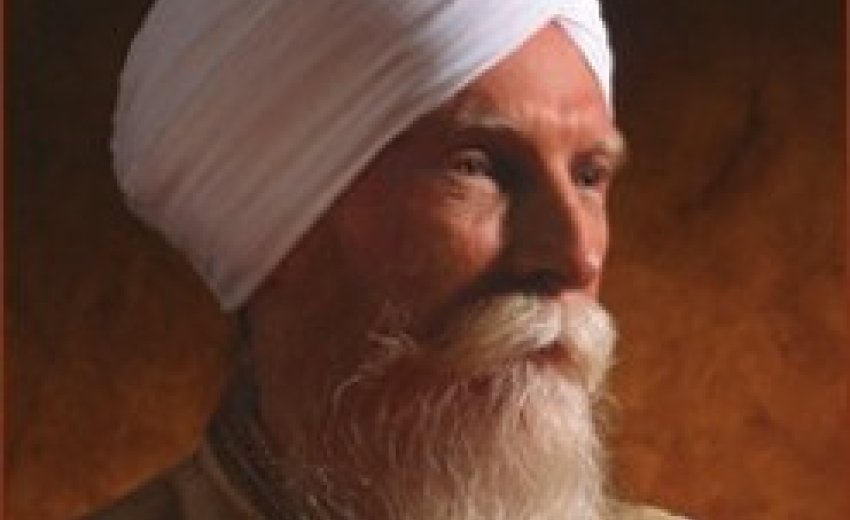 Pritpal Singh shares some reflections on the Salok of Guru Nanak’s JapJi Sahib
Pritpal Singh shares some reflections on the Salok of Guru Nanak’s JapJi Sahib
“The Salok brings self-satisfaction, elevation, acknowledgement, and respect.”
— from the Teachings of the Siri Singh Sahib Yogi Bhajan (1)
Jap Ji closes with the Salok (short poetic verse), which begins with the following:
![]()
pavaṉ guru pāṉī pitā mātā dharat mahat.
Air is the Guru, Water is the Father, and Earth is the Great Mother of all.
July 14, 2016: In the first line of this Salok Guru Nānak reminds us of the trinity of our primary relationships of Father, Mother and “Guru” (our connection to the Divine). This trinity directly invokes three of the elements, or Tattvas, namely Air, Water and Earth. In other scriptures Guru Nānak describes how in the beginning of creation Air was the first element that was created and that out of the Air came the second element, Water. Here he says that Air is our Guru – in that air is the carrier of “Prāna” or life force, which is the gift of the Breath of Life; the breath that sustains life; and the breath with which we are able to intone the sacred words of the Guru or Shabad Guru, opening a gateway to experience the Divine through the power of the Sound Current or Naad. Mother and Father personify the divine and cosmic qualities of the universe, but they also represent the very basic elements of Earth and Water. The feminine creative aspect of the Mother is embodied in the element of Earth. In all life, birth of a child establishes the relationship for Motherhood. But Fatherhood is more fluid, as in the animal world where paternity does not normally lead to the role of Fathering. Even in our human experience, a genetic relationship does not necessarily guarantee Fathering. As we learn about the world by watching our Father engage in it, we can also learn from watching the flowing of Water to understand how to navigate life, to adapt to this world, however it presents itself to us. Guru Nānak refers to Earth not as just the Mother, but actually, the Great Earth (dharat mahat) meaning all of Creation (prakirtī), from which our very bodies are made out of the atoms present in this Earth.
In the second line of this Salok, Guru Nanak says:
![]()
divas rāt du-i dā-ī dā-i-ā khaylai sagal jagat.
Day and night are the two nurses, in whose lap all the world is at play.
“Divas rāt du-i dā-ī dā-i-ā” says that there are two “nurses” or guardian angels who represent the forces of Creation, providing everything we need in both the active daytime and in the non-active nighttime. “Khaylai sagal jagat” says that this life is a game – a game to resolve our Karma and embrace our higher self by walking on the path of Dharma. Some say that there are three games described in this Salok. The first is the game of the whole world or universe. In this game we are a small part of the huge backdrop of events. The second is the game of being human. In this game we are given the opportunity to understand the gifts and challenges that we receive as human beings in this life. And the third game is the game of the divinely aligned being, or Gurmukh. In this game we must embrace the highest ideals and live to them; find our way through the ultimate test of our character; and go beyond a mere “human” experience to embody the highest consciousness of being “Jivan Mukht” or liberated while alive. The question implied is; will we just be played by the forces in our life; or will we become active players, intimately engaged and spontaneous with each play? The whole of Jap Jī is a series of instructions as to how to find our victory in this game of life.
Then in the third line Guru Nanak says:
![]()
changi-ā-ī-ā buri-ā-ī-ā vāchai dharam hadur
Good deeds and bad deeds; the record is read out in the Presence of the Lord of Dharma.
We cannot hide from our misdeeds. They are imprinted upon our soul. As we walk on this path of Dharma we have entered into a contract with our divine destiny. Once we accept the promise of the divine alignment of our soul, then the Divine (God) demands us to hold to our end of the contract. This holding us to account is personified here as “Dharam hadur” (Lord of Dharma), often referred to as “Dharam Raj” (King of Dharma) and it implies an infallibility of discernment as to whether our actions are actually true to our highest intentions and commitments.
In the fourth line Guru Nanak says:
![]()
karamī āpo āpaṉī kay nayṟai kay dur
According to their own actions, some are drawn near, and some are sent far.
Each of us is innately part of the Oneness of the Divine. The Divine is always with us but through conscious and unconscious actions we turn our attention away. Here we are being reminded of the Law of Karma; that our actions have direct effect on the elevation or decline of our soul’s progress in this life. But this also reveals how the inverse of this is a practical way for us to measure the correctness of our choices; for as we notice our life to be more or less filled with the presence of Guru’s Grace, that shows us if our choices are steering our soul toward or away from our elevation in the Divine.
“It is through our actions we recognize God is near us or God is away from us. Those who dwell in God, God is always within them. And those who do not dwell in God, dwell in their ego and God is far away…”
– Siri Singh Sahib Yogi Bhajan
Then Guru Nanak says in the fifth line:
![]()
jinī nām dhi-ā-i-ā ga-ay masakat ghāl
Those who have meditated on the Nam and departed after working by the sweat of their brows.
Here we are directed into the state of pratyahar, maintaining focus on the Divine through meditation on the divine word or Nām. Further, it is not enough to only achieve this meditative state while in stillness or isolation, but it is a higher achievement if we can also keep this meditative focus during our manual labors in a fully engaged life, in honesty and righteousness. These achievements can simply be enough in this lifetime, so that then our soul is free to move on from this life.
Guru Nanak ends this Salok, with:
![]()
nānak tay mukh ujalay kaytī chhuṯī nāl
O Nanak, their faces are radiant in the Court of the Lord, and many are saved along with them!

